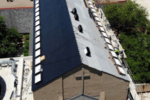May 2013
Leadership in a Time of Crisis
From the Ashes
On December 23, 2012, The Church of St. Luke and St. Matthew suffered a serious fire as the result of an arson attack. An unknown person poured gasoline across the entrances of the church and set fire to them in the early hours of the morning. The portico, narthex, several offices, and the back of the nave were severely damaged. Smoke damaged almost every other room in the building.
The fire came on the heels of a major hurricane relief effort undertaken by the congregation and community known as “Occupy Sandy.” For nearly two months, the church served as home base for the largest grass-roots hurricane relief effort in the City of New York. Over 60,000 volunteers were trained in the church in less than 8 weeks. Millions of pounds of donated items were distributed. The nave and sanctuary became a holy warehouse stocked with love and fueled by faith. FEMA, the Red Cross, and The White House Office of Faith Based Initiatives referred to the effort as “a miracle.”
The recovery work was miraculous and the community was exhausted as we moved into Christmas. The fire just about burned up the last bit of oxygen we had left.
Arriving in front of a charred church to find weeping parishioners, water pouring out of the entrances, and every media outlet in the city perched across the street was not what I had in mind for the 4th Sunday in Advent.
As the community gathered, it was clear that we could not enter the church for worship. We decided to walk around the corner and pray with our Baptist brothers and sisters. They were having their Christmas service a day early -which was just what we needed!
After an uplifting time of prayer and a lengthy conversation with the building inspector, it was decided that we could enter the church the following day for Christmas Eve services. Word spread via social media. Neighbors and friends from everywhere began arriving with decorations- many folks unknown to us. As it got close to the start of the 10:00 pm service, I was still welcoming people in a burned-out hallway, making sure visitors could find the alternate route into the nave. Before I knew it, the procession was beginning and I found myself in the midst of a church filled with candlelight and the largest Christmas Eve attendance in 20 years.
It was a resurrection moment for many of us. Many tears were shed. We remembered our baptisms. We lit the new fire. We gave thanks for the spirit. It was Christmas Eve and The Great Vigil of Easter and Pentecost all rolled into one.
Christmas was followed by many meetings with Church Insurance, questions about restoration, and inevitably questions about the parish’s purpose and mission. The fire seemed to refine our sense of vision and collective passion for the gospel. If the fire was a consequence of our unprecedented relief efforts, what should we do? Certainly not retreat in fear!
The Wardens and vestry modeled the openness to the Spirit needed at the moment. Rather than giving into panic mode, they asked "what does this mean for us and our ministry in this neighborhood and this city." It was the right question and our ministries and building are emerging stronger after the fire in large part due to their willingness to see God in the flames and smoke.
As I prepared for our annual meeting early in the new year, I knew it could not be the usual rigmarole of financial reports, guild updates, elections, and potluck. Of course we did all that (as efficiently as possible), but I felt the need to do things differently. It seemed the appropriate moment to engage in the hallowed practice of story telling.
Two days before the meeting I heard a story on NPR’s This American Life with Ira Glass that moved me. The story was told by the father of a four-year-old girl. He recounted the moment that his daughter asked him what Christmas meant. He explained to her that it was the celebration of the birth of Jesus and she wanted to know more about it. So, he bought her a kid’s Bible and they would read it at night. The daughter loved the stories. The two talked about the stories each night and about Jesus teaching to love your neighbor as yourself.
One day as they were driving past a big church, the daughter saw an enormous crucifix and said, “Who is that?!” The father realized that he had never really told her that part of the story, so he said, “Yeah, well, that's Jesus and I forgot to tell you the ending and yeah, you know, he ran afoul of the Roman government. This message that he had was so radical and unnerving to the prevailing authorities of the time that they had to kill him. They came to the conclusion that he would have to die. That message was too troublesome."
Later in the month, the daughter’s preschool was closed for Martin Luther King Day. The father was sitting at the kitchen table with his daughter when he plopped down the arts section of the local newspaper. There was a huge drawing of Martin Luther King by a ten year-old kid from a local school. His daughter asked, "Who's that?" The father said, "Well, as it happens, that is Martin Luther King, and he's why you're not in school today, because we're celebrating his birthday." And she said, "So who is he?" And the father said, "Well, he was a preacher." She looks up to him and says, "For Jesus?" And the father says, "Yeah, well, actually he was. But there was another thing that he was really famous for, which is that he had a message." And she says, "What was his message?"
The father says, "Well, he said that you should treat everybody the same, no matter what they look like." The daughter thought about that for a minute and she said, "Well, that's what Jesus said." And the father says, "Yeah, I guess it is. I never thought of it that way, but yeah. That is sort of like love your neighbor as yourself." She thought for a minute and looked up at her father and said, "Did they kill him too?"
We will never know why someone torched our church the night before Christmas Eve. But the experience of adversity in the midst of life-giving ministry was an invitation for our congregation to stand in the prophetic line of faithful communities who have given themselves up in service to the Gospel. We left internal bureaucracy behind in favor of common narrative. It turned out that storytelling was the right focus for our annual meeting. It led to new levels of commitment throughout the congregation. People wanted passersby to look up and see us rebuilding and connect the dots from church, to historic change-agents, to prophets, to the living God in our midst. The fire we suffered ignited a passion for justice and peace that is burning brightly in emergent ministries, renewed faith, a restored building, and an understanding that resurrection must be preceded by some kind of death. Our responsibility is to tell the story in hope of setting others ablaze.
As far as the building goes, Church Insurance has been fantastic to work with. Our restoration is on track to be completed by December 2013 and we look forward to a big community celebration next Christmas Eve.
Michael Sniffen is rector of The Church of St. Luke and St. Matthew in Brooklyn, NY. He is also a PhD candidate (ABD in Liturgical Studies and Homiletics) at Drew Theological School in Madison, NJ.
Resources
- The Church of St. Luke and St. Matthew, Brooklyn, New York
- “Church Builds Community Through Post Sandy Relief Work,” Episcopal Digital Network
- “Flames and Faith” by Judy Hoover, ECF Vital Practices
- Parish Inventory Workbook, Church Pension Group
- Property & Casualty Resources from Church Insurance: Property & Casulalty Overview and Property & Casulaty Resource Forms
- Public Narratives, Leadership Development Initiative
- “Suspicious Fire Chars Part of Brooklyn Church,” New York Times






